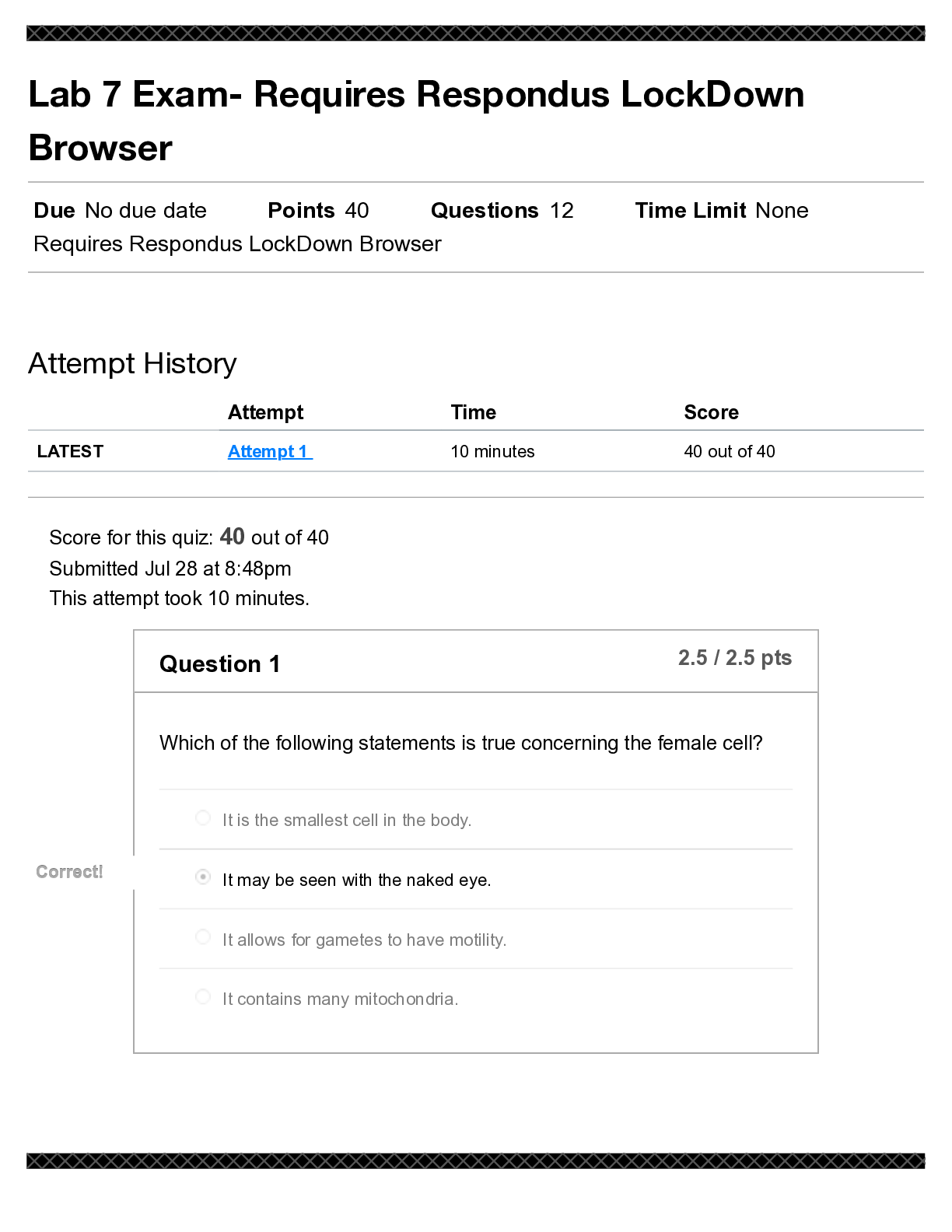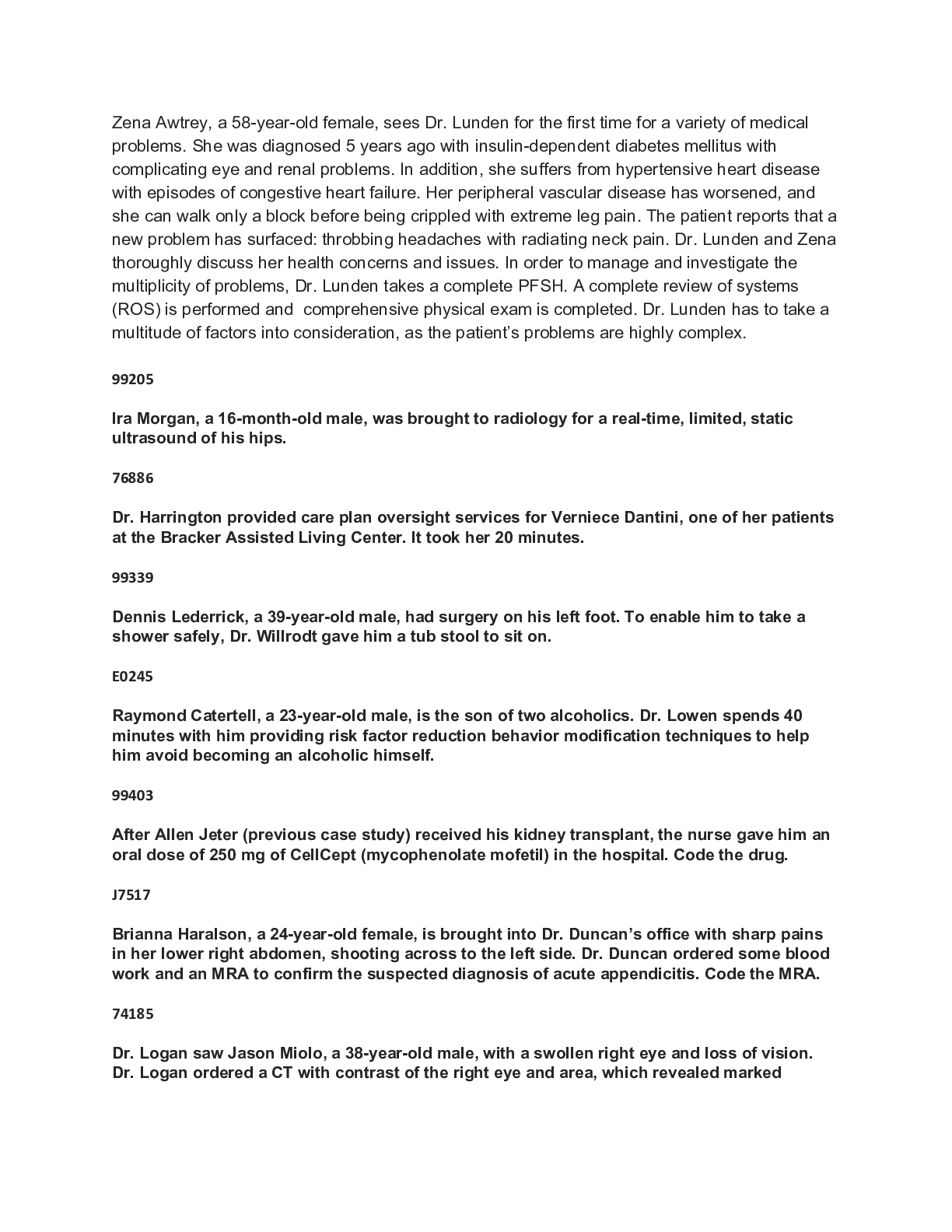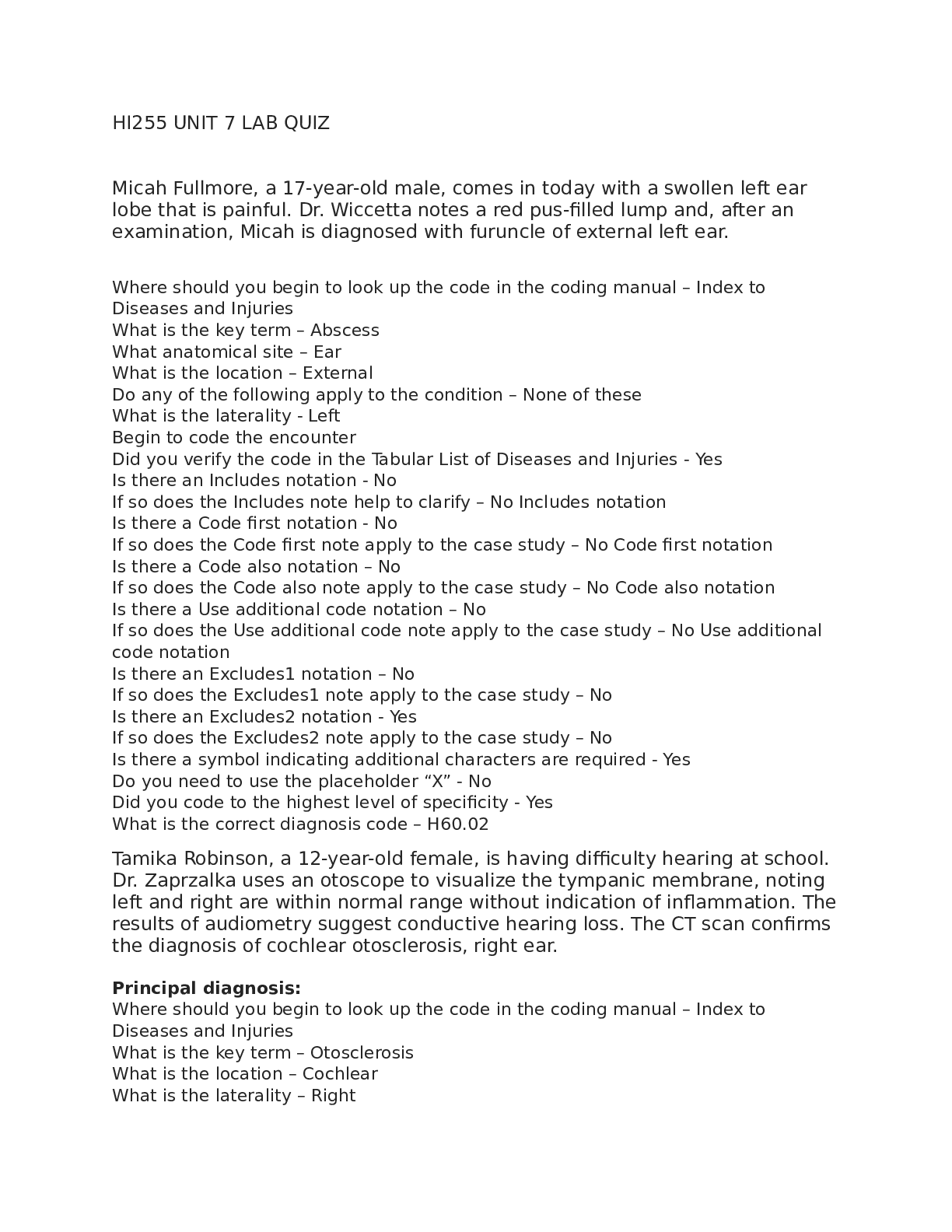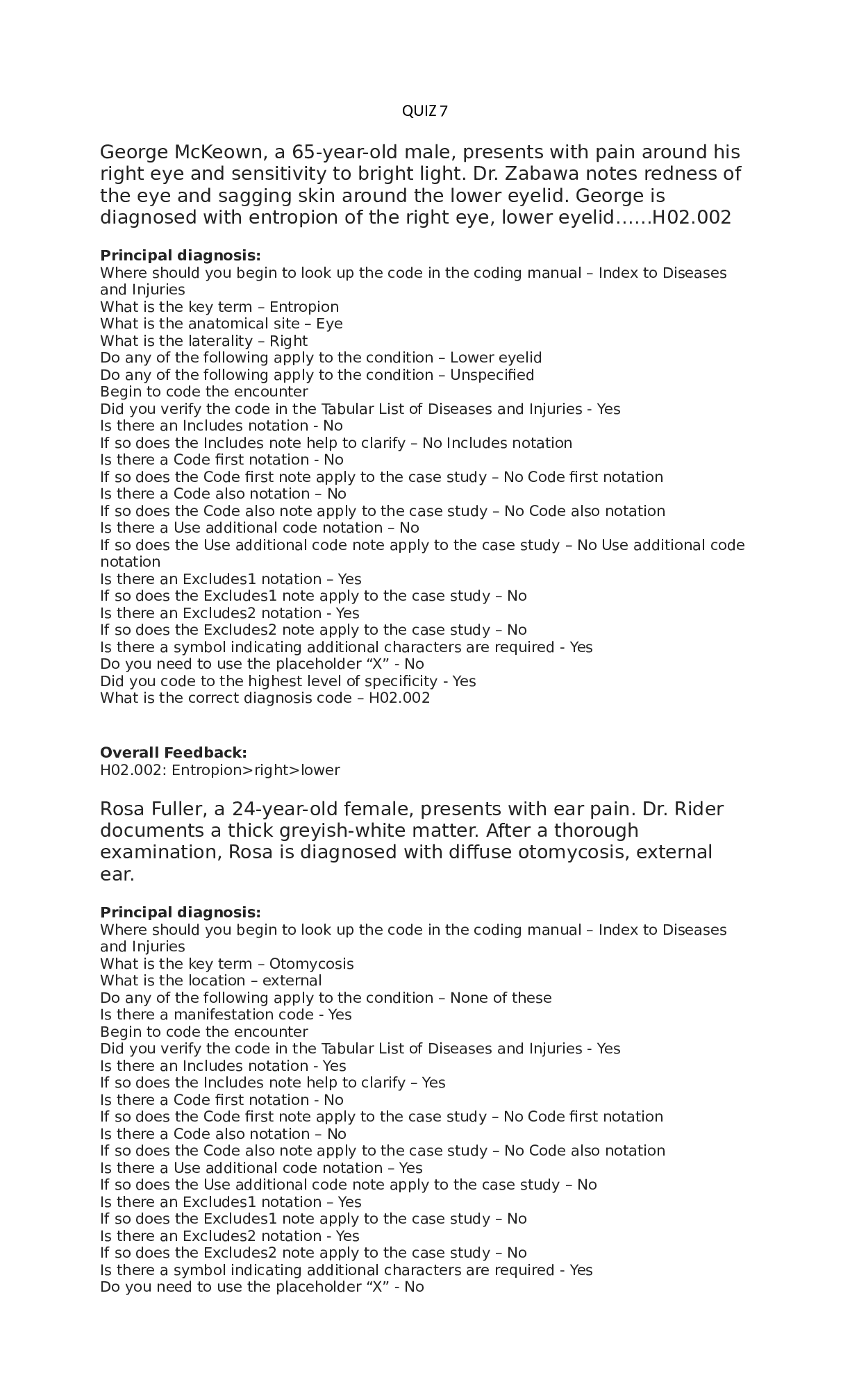BIOS-252 Week 1 Muscular System – Lab Assignment (SOLVED)
Document Content and Description Below
BIOS-252 Week 1 Muscular System – Lab Assignment Week 1 Muscular System Lab Learning Objectives: • Describe the major roles of muscle tissue • Demonstrate how muscle contraction and rela ... xation are linked to thermoregulation, digestion, circulation, and motor function. • Differentiate smooth, cardiac, and skeletal muscle based on their microstructure. • Describe the general organization and structural components of a skeletal muscle. • Explain the principle of the sliding filament mechanism of skeletal muscle Introduction Did you know that you have more than 600 muscles in your body? Some of these muscles help to express your emotions through gesticulation and facial expressions, and the heart beats more than 3.3 billion times over 80 years! In this simulation, you will take a closer look at the three distinct muscle tissues we find in the human body and what purpose they serve. Your first task is to learn about the different types of muscle tissues found in the human body. Interact with the anatomical 3D holograms to explore the distribution and main functions of skeletal, smooth, and cardiac muscle tissues. Using the control panel to navigate the different models, you will collect information about the tissues to solve different scenarios related to the muscular system. Continue your investigation by examining the muscle tissues at the cellular level to see how the individual muscle cells of each muscle tissue compare to one another. Pick up the cellular 3D models and examine the nuclei, myofibrils, mitochondria and more to understand how the intracellular components enable each muscle cell to perform the functions characteristic for that muscle tissue. Follow the pathway that allows a nerve signal initiated in the brain to induce an actual muscle contraction in a skeletal muscle. Dive into the molecular level and see how the myofibrils are arranged in repeating units of sarcomeres. Compare a 3D model of a sarcomere to its electron micrograph and observe the changes that take place during contraction and relaxation. Finally, immerse yourself in the process of the sliding filament theory by interacting with the contractile proteins of a sarcomere. Assignment: Part 1: Labster: “Muscle Tissues: An Overview” As you complete the lab, have the lab report ready to record data. The theory section of Labster is a good resource for information. Part 2: Complete the lab report Muscular System Lab Report 1. Describe the different muscles tissues using the table: (4 points) Fibers Voluntary or Location Nervous Involuntary system control: peripheral NS or Autonomic NS? Skeletal muscle Striated, tubular, and multi- nucleated Voluntary Usually attached to bone Peripheral Smooth muscle Non-striated, spindle-shaped, and uninucleated Involuntary Covering walls of internal organs Autonomic Cardiac muscle Striated, branched, and uninucleated Involuntary Only covering walls of the heart Autonomic 2. What is a sarcomere? (½ point) The basic contractile functional unit of a myofibril. 3. a. Which contractile protein makes up the thick filament? (½ point) The contractile protein that makes up the thick filament is myosin. b. Which contractile protein makes up the thin filament? (½ point) The contractile protein that makes up the thin filament is actin. 4. What ion binds to troponin and causes a conformational shape change to occur, moving the troponin away from the myosin head-binding sites? (½ point) Calcium or Ca2+ is the ion that binds to troponin and causes a confirmational shape change to occur, moving the troponin away from the myosin head-binding sites. 5. In the following image of a relaxed sarcomere, identify: (3 points total; ½ point each) Actin Myosin M-line A-band I-band Z-disc 6. Describe what is occurring at each of the 5 steps below. (5 points; 1 point each step) 1. An action potential arrives at neuromuscular junction. 2. ACh is released from the neuron and binds to the muscle cell, causing it to depolarize. 3. The depolarization wave spread across the muscle cell plasma membrane and it enters invaginations known as T-tubules. 4. The depolarization wave finally reaches the sarcoplasmic reticulum where storages of calcium are released into the cell cytoplasm. 5. Calcium binds to troponin, myosin and actin interact to begin a muscle contraction. 6. Discuss 2 functions of the muscular system beyond movement of the skeleton. (1 point; ½ point per function) One function of the muscular system beyond movement of the skeleton is thermoregulation. This function is carried out by the skeletal tissue. Most of the heat produced by muscle is applied to sustain average body temperature. Uncontrolled contractions by skeletal muscles, identified as shivering, can boost the level of heat production. Another function of the muscular system beyond movement of the skeleton is storing and moving substances within the body. This is achieved by continuous contractions of rings of smooth muscles called sphincters, which inhibit loss of the substances contained by hollow organs. For example, transitory storage of food in the stomach is feasible since smooth muscle sphincters shut off the channels of the stomach. Grading Rubric for Lab Report Activity Deliverable Points Part 1 Complete Labster 15 Part 2 Complete lab report and answer questions 15 Total Complete all lab activities 30 [Show More]
Last updated: 3 years ago
Preview 1 out of 5 pages

Buy this document to get the full access instantly
Instant Download Access after purchase
Buy NowInstant download
We Accept:

Also available in bundle (1)
Click Below to Access Bundle(s)

BIOS 252 Anatomy And Physiology II With Lab BUNDLE (LATEST UPDATES) | Questions and Answers/ ALL GRADED A+
BIOS 252 Week 1 Case Study Assignment: Muscles BIOS-252 Week 1 Muscular System – Lab Assignment BIOS 252 Week 1 Discussion Question: Skeletal and cardiac muscle tissues BIOS-252 Week 2 Case Study...
By Prof. Goodluck 3 years ago
$13.5
15
Reviews( 0 )
$11.50
Can't find what you want? Try our AI powered Search
Document information
Connected school, study & course
About the document
Uploaded On
Sep 05, 2022
Number of pages
5
Written in
All
Additional information
This document has been written for:
Uploaded
Sep 05, 2022
Downloads
0
Views
282

.png)


.png)


 (1).png)
.png)
.png)
















